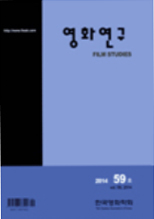- 영문명
- Sang-Ho Park’s THE DMZ: Reconsidering Images of Painful Korean War and Antiwar Rhetoric
- 발행기관
- 한국영화학회
- 저자명
- 김은영
- 간행물 정보
- 『영화연구』제56호, 73~102쪽, 전체 30쪽
- 주제분류
- 예술체육 > 예술일반
- 파일형태
- 발행일자
- 2013.06.30
6,400원
구매일시로부터 72시간 이내에 다운로드 가능합니다.
이 학술논문 정보는 (주)교보문고와 각 발행기관 사이에 저작물 이용 계약이 체결된 것으로, 교보문고를 통해 제공되고 있습니다.

국문 초록
영문 초록
This paper attempts to analyze how THE DMZ(Bimujang Jidae),directed by Sang-Ho Park, recalls and shows the tragic legacy left behind by the Korean war in the mid-1960s, and examines the independent filmmaking system the producer and film director choose, taking a compromising attitude with the official historical narratives by the state power. The film is concerned with the tragic division of Korean peninsular. The story is about two war orphans, a boy and a girl, who lose their families at the demilitarized zone right after the Korean War. They are wandering over the zone to find their mothers. After the boy’s death, the girl comes south over the border. The film takes both newsreels and documentary-like scenes which melded with the fictional story in an unusual way. Images of painful Korean War are visualized effectively. However its antiwar rhetoric camouflages anti-Communism controlled by the state, because the production had to work hard to challenge the censorship which the authorities in the 1960s had been very keen on it. Like many anti-Communist films, the film was directed at providing superiority over the enemy, at demonstrating the evilness of the other side. Finally, the film provides a simple construction of the polarities of ‘us’ and ‘them’ through the Cold War narrative. Looking at The DMZ, we can see how the cold war with ubiquitous presence has socialized people in war-torn country, Korea. The US-led anti-Communist sentiment has prevailed among many Koreans after Korean War. Thus. the Cold War politics can be read as collective national paranoia in Korea. Film propaganda activities had to play a major role in the process of social conditioning. In conclusion THE DMZ is a example of the Cold War propaganda model, although it conveys antiwar messages. In the Cold war context, the film’s conclusion therefore constructs the South Korean society as peaceful in contrast the invader. On the other hand the figure of the North Korea offers great potential construction of a monstrous alterity.
목차
1. 들어가는 말
2. 1960년대 전쟁의 재현방식과 <비무장지대>의 제작방식
3. 전쟁으로 인한 고통의 이미지와 분단의 놀이체험
4. 연민과 반전의 수사학
5. 나오는 말
키워드
해당간행물 수록 논문
참고문헌
관련논문
예술체육 > 예술일반분야 BEST
- 생성형 AI 도구와 디자이너의 협업 프로세스 개발 - 이미지를 통한 아이디어 확산에서 고해상도 렌더링까지
- 영화 [올드보이]와 소포클레스 「오이디푸스 왕」의 상동성 연구
- ‘일과 삶의 균형(Work-Life Balance)’ 척도 개발을 위한 연구
예술체육 > 예술일반분야 NEW
더보기최근 이용한 논문
교보eBook 첫 방문을 환영 합니다!

신규가입 혜택 지급이 완료 되었습니다.
바로 사용 가능한 교보e캐시 1,000원 (유효기간 7일)
지금 바로 교보eBook의 다양한 콘텐츠를 이용해 보세요!



